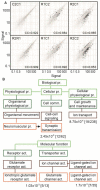Cholinergic Stress Signals Accompany MicroRNA-Associated Stereotypic Behavior and Glutamatergic Neuromodulation in the Prefrontal Cortex
- PMID: 32503154
- PMCID: PMC7355890
- DOI: 10.3390/biom10060848
Cholinergic Stress Signals Accompany MicroRNA-Associated Stereotypic Behavior and Glutamatergic Neuromodulation in the Prefrontal Cortex
Abstract
Stereotypic behavior (SB) is common in emotional stress-involved psychiatric disorders and is often attributed to glutamatergic impairments, but the underlying molecular mechanisms are unknown. Given the neuro-modulatory role of acetylcholine, we sought behavioral-transcriptomic links in SB using TgR transgenic mice with impaired cholinergic transmission due to over-expression of the stress-inducible soluble 'readthrough' acetylcholinesterase-R splice variant AChE-R. TgR mice showed impaired organization of behavior, performance errors in a serial maze test, escape-like locomotion, intensified reaction to pilocarpine and reduced rearing in unfamiliar situations. Small-RNA sequencing revealed 36 differentially expressed (DE) microRNAs in TgR mice hippocampi, 8 of which target more than 5 cholinergic transcripts. Moreover, compared to FVB/N mice, TgR prefrontal cortices displayed individually variable changes in over 400 DE mRNA transcripts, primarily acetylcholine and glutamate-related. Furthermore, TgR brains presented c-fos over-expression in motor behavior-regulating brain regions and immune-labeled AChE-R excess in the basal ganglia, limbic brain nuclei and the brain stem, indicating a link with the observed behavioral phenotypes. Our findings demonstrate association of stress-induced SB to previously unknown microRNA-mediated perturbations of cholinergic/glutamatergic networks and underscore new therapeutic strategies for correcting stereotypic behaviors.
Keywords: acetylcholinesterase; cholinergic; glutamatergic; hippocampus; microRNAs; motor control; prefrontal cortex; stereotypic behavior.
Conflict of interest statement
The authors declare no conflict of interest.
Figures








Similar articles
-
Hippocampal microRNA-132 mediates stress-inducible cognitive deficits through its acetylcholinesterase target.Brain Struct Funct. 2013 Jan;218(1):59-72. doi: 10.1007/s00429-011-0376-z. Epub 2012 Jan 14. Brain Struct Funct. 2013. PMID: 22246100 Free PMC article.
-
Changes in the Prefrontal Glutamatergic and Parvalbumin Systems of Mice Exposed to Unpredictable Chronic Stress.Mol Neurobiol. 2018 Mar;55(3):2591-2602. doi: 10.1007/s12035-017-0528-0. Epub 2017 Apr 18. Mol Neurobiol. 2018. PMID: 28421533
-
Prefrontal beta2 subunit-containing and alpha7 nicotinic acetylcholine receptors differentially control glutamatergic and cholinergic signaling.J Neurosci. 2010 Mar 3;30(9):3518-30. doi: 10.1523/JNEUROSCI.5712-09.2010. J Neurosci. 2010. PMID: 20203212 Free PMC article.
-
Molecular mechanisms involved in the prevention and reversal of ketamine-induced schizophrenia-like behavior by rutin: the role of glutamic acid decarboxylase isoform-67, cholinergic, Nox-2-oxidative stress pathways in mice.Mol Biol Rep. 2021 Mar;48(3):2335-2350. doi: 10.1007/s11033-021-06264-6. Epub 2021 Apr 3. Mol Biol Rep. 2021. PMID: 33811574
-
Glutamatergic drive of the dorsal raphe nucleus.J Chem Neuroanat. 2011 Jul;41(4):247-55. doi: 10.1016/j.jchemneu.2011.04.004. Epub 2011 Apr 27. J Chem Neuroanat. 2011. PMID: 21550397 Free PMC article. Review.
Cited by
-
Regulators of cholinergic signaling in disorders of the central nervous system.J Neurochem. 2021 Sep;158(6):1425-1438. doi: 10.1111/jnc.15332. Epub 2021 Mar 19. J Neurochem. 2021. PMID: 33638173 Free PMC article. Review.
References
Publication types
MeSH terms
Substances
Grants and funding
LinkOut - more resources
Full Text Sources

